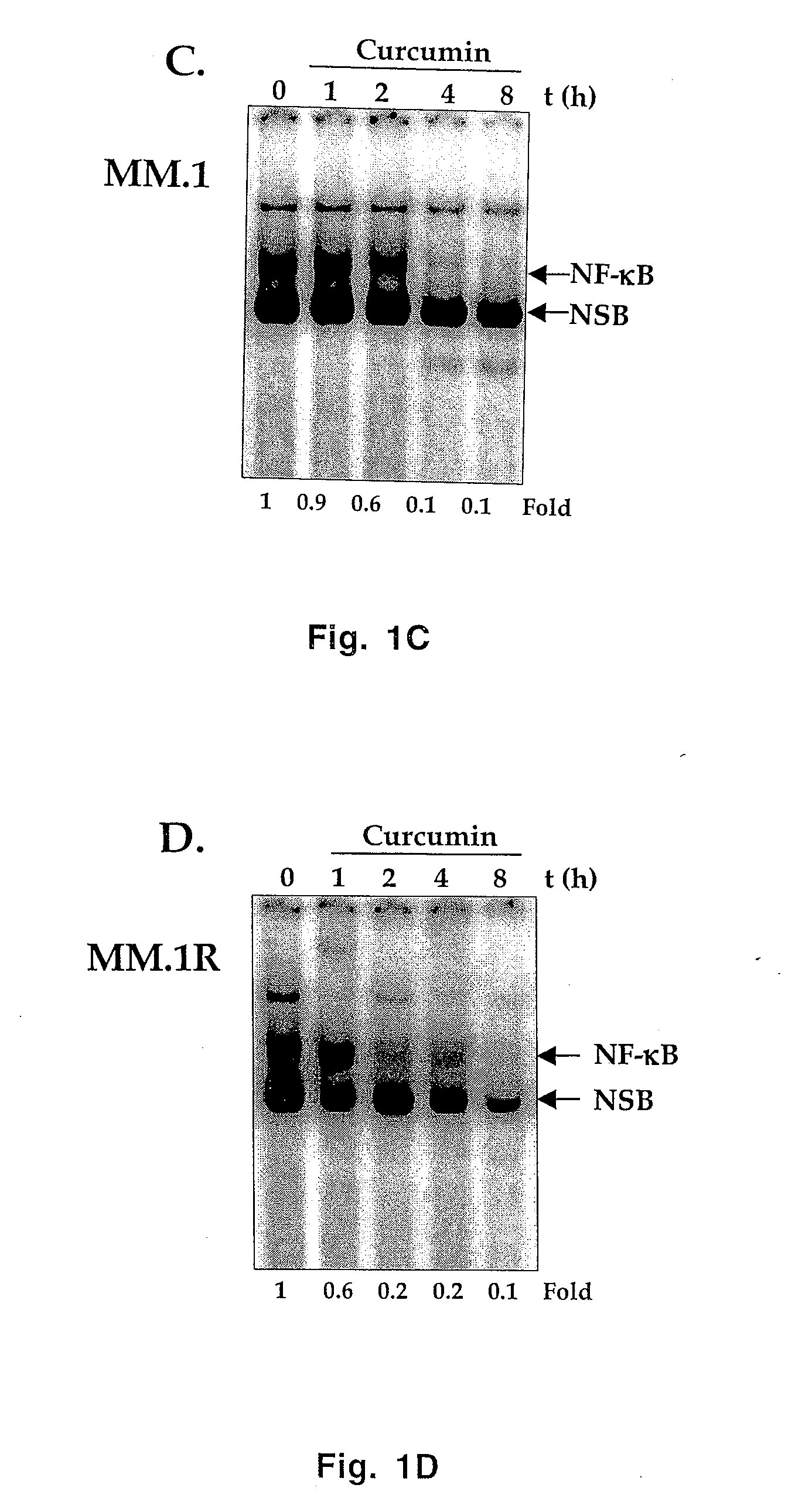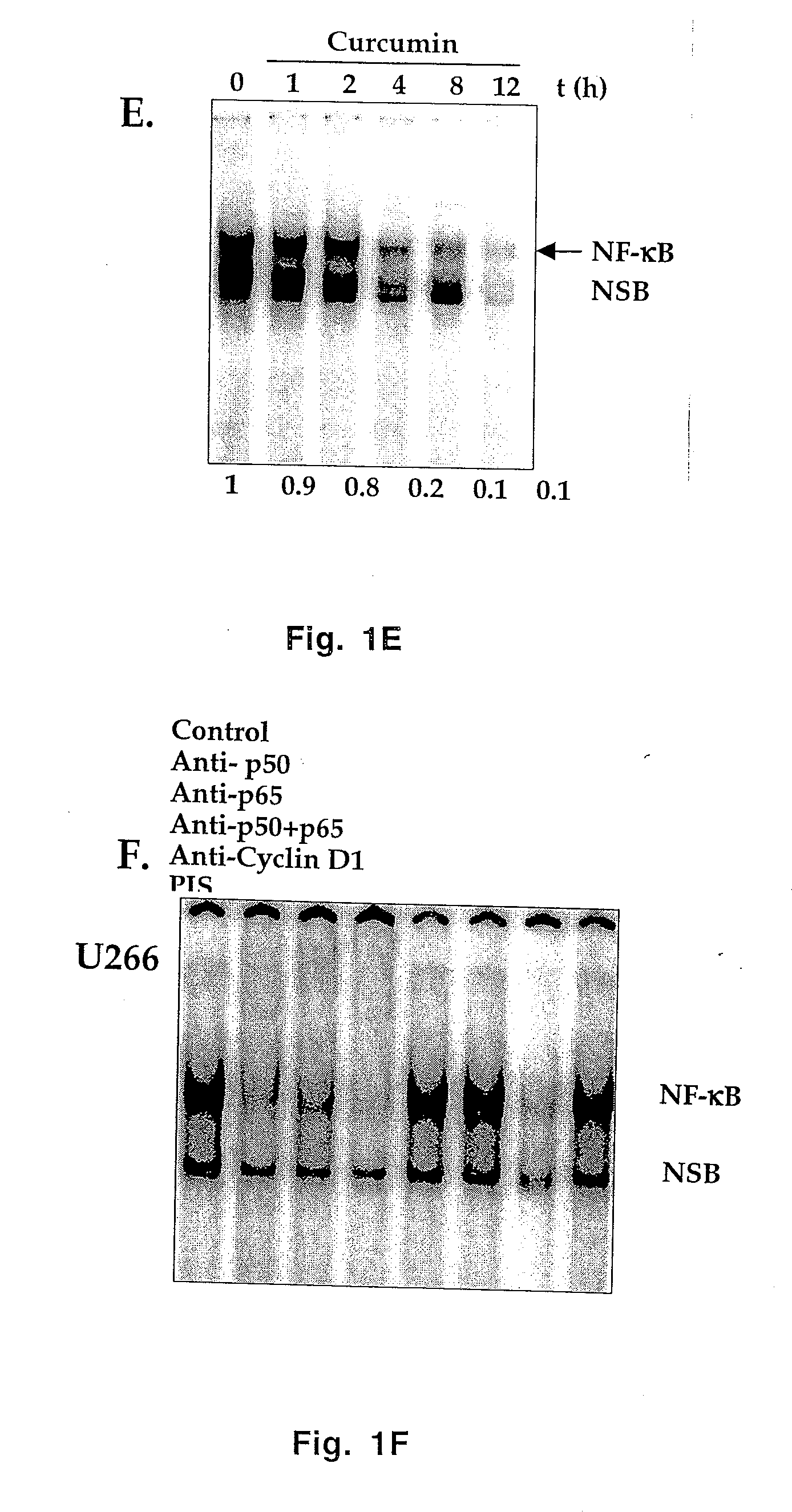Treatment of Human Multiple Myeloma by Curcumin
a curcumin and multiple myeloma technology, applied in the field of cancer biology, can solve the problems of inability to treat malignancy, insufficient pharmacologically safe and effective agents, etc., and achieve the effects of suppressing constitutive ib phosphorylation, little or no toxicity, and preventing nuclear retention of p65
- Summary
- Abstract
- Description
- Claims
- Application Information
AI Technical Summary
Benefits of technology
Problems solved by technology
Method used
Image
Examples
example 1
Cells and Reagents
[0044] Human multiple myeloma cell lines U266, RPMI 8226, and MM.1 were obtained from the American Type Culture Collection (Rockville, Md.). Cell lines U266 (ATCC#TIB-196) and RPMI 8226 (ATCC#CCL-155) are plasmacytomas of B cell origin. U266 is known to produce monoclonal antibodies and IL-6. RPMI 8226 produces only immunoglobulin light chains and there is no evidence for heavy chain or IL-6 production. Doxorubicin (Dox-6)- and melphalan (LR-5)-resistant clones of RPMI 8226 were provided by Dr. Willium Dalton (H. Lee Moffitt Cancer Center and Research Institute, Tampa, Fla.)
[0045] The MM.1 (also called MM.1S) cell line, which is established from the peripheral blood cells of a patient with IgA myeloma, secretes lambda light chain, is negative for the presence of EBV genome, and expresses leukocyte antigen DR, PCA-1, T9 and T10 antigens. MM.1R is a dexamethasone-resistant variant of MM.1 cells. These two cell lines was provided by Dr. Steve T. Rosen of Northweste...
example 2
Preparation of Nuclear Extracts for NF-κB
[0050] Nuclear extracts were prepared according to Bharti et al. (2003). Briefly, 2×106 cells were washed with cold PBS and suspended in 0.4 ml of hypotonic lysis buffer containing protease inhibitors for 30 min. The cells were then lysed with 12.5 μl of 10% Nonidet P-40. The homogenate was centrifuged, and supernatant containing the cytoplasmic extracts was stored frozen at −80° C. The nuclear pellet was resuspended in 25-μl ice-cold nuclear extraction buffer. After 30 min of intermittent mixing, the extract was centrifuged, and supernatants containing nuclear extracts were collected. Protein content was measured by the Bradford method. If the supernatants were not used immediately, they were stored at −80° C.
example 3
Electrophoretic Mobility Shift Assay for NF-κB
[0051] NF-kB activation was analyzed by electrophoretic mobility gel shift assay (EMSA) as described previously (Chaturvedi et al., 1994). In brief, 8-μg nuclear extracts prepared from curcumin-treated or untreated cells were incubated with 32P end-labeled double-stranded 45-mer of NF-kB oligonucleotide from human immunodeficiency virus-1 long terminal repeat (5′-TTGTTACAAGGGACTTTCCGCT GGGGACTTTCCAG GGAGGCGTGG-3′, SEQ ID NO. 4) for 15 min at 37° C., and the DNA-protein complex was resolved in a 6.6% native polyacrylamide gel. Radioactive bands from the dried gels were visualized and quantitated by PhosphorImager (Molecular Dynamics, Sunnyvale, Calif.) using ImageQuant software.
PUM
| Property | Measurement | Unit |
|---|---|---|
| Dimensionless property | aaaaa | aaaaa |
| Dimensionless property | aaaaa | aaaaa |
| Fraction | aaaaa | aaaaa |
Abstract
Description
Claims
Application Information
 Login to View More
Login to View More - R&D
- Intellectual Property
- Life Sciences
- Materials
- Tech Scout
- Unparalleled Data Quality
- Higher Quality Content
- 60% Fewer Hallucinations
Browse by: Latest US Patents, China's latest patents, Technical Efficacy Thesaurus, Application Domain, Technology Topic, Popular Technical Reports.
© 2025 PatSnap. All rights reserved.Legal|Privacy policy|Modern Slavery Act Transparency Statement|Sitemap|About US| Contact US: help@patsnap.com



